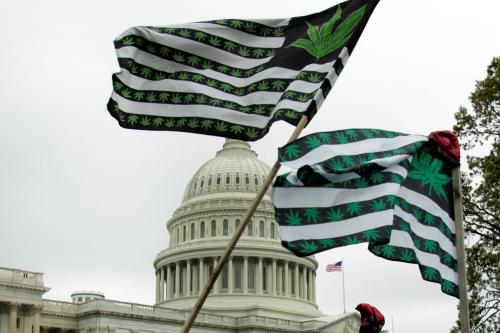George W. Bush took the oath of office on January 20, 2001, the first president elected in the 21st century. Unfortunately, relatively few members of the new administration went to work that week, or in the weeks that followed. In fact, if history is any guide, it will be nine or ten months before the new president is firmly in control of the government. That is roughly when the last of President Bush’s nominees to the subcabinet and independent agencies are likely to complete the presidential appointment process. Only then can the real work of the administration fully begin.
Americans may be dismayed by the delays, but they should not be surprised. Since 1960, every president has taken longer and longer to complete his appointments. President Kennedy’s top appointees were not in place until mid-April, Nixon’s until mid-May, Carter’s until July, Reagan’s until August, Bush’s until mid-September, and Clinton’s until October. President Bush will be lucky to have a full administration by November.
The delays reflect many factors, not least that the number of positions open for appointment has grown steadily over the decades. In 1961, for example, Kennedy filled a grand total of 196 Senate-confirmed appointments in the cabinet departments. Thirty years later, Clinton had nearly 800 to fill. And these figures do not include the growing number of posts in the independent agencies, the advisory board positions, and lesser political posts, which now number in the 5,000 range.
The review process has also grown more onerous and complex with each passing scandal. The number of forms has increased, as has the list of questions and disclosure requirements. And those questions now penetrate more deeply—and some would say intrusively—
into a broader range of personal issues than ever before. At a time when our government is vigorously pursuing improved ways to ensure the privacy of our citizens on the Internet, it seems ironic that we force potential leaders of the executive and judicial branches to reveal ever more details about their personal lives as a condition of public service.
The increasing complexity of the process is more than a bureaucratic nuisance. It also has reduced the number of talented Americans willing to accept the call to presidential service. Presidential recruiters report that it takes more calls to find candidates willing to subject themselves to the process and more work to keep candidates from bolting once the process begins. The number of initial turndowns is rising, as is the number of later withdrawals. A recent survey of top executives in the private sector, conducted for The Presidential Appointee Initiative, found that more than a fifth of those who’d been considered for a presidential appointment had turned it down.
It is little wonder that talented people would opt out of a process that opens every detail of their lives to the fullest public scrutiny or that they might be frightened off by a White House questionnaire that asks whether they “have ever had any association with any person, group, or business venture that could be used, even unfairly, to impugn or attack your character and qualifications for a government position?”
Filling out these forms, answering the scores of exhaustive questions, and enduring the reviews and background checks and investigations now routinely takes half a year or more. That’s a lot of time out of the life of these busy people, and it’s simply an obstacle course that too few choose to enter.
We know that delays are not the only reason for America’s civic and corporate leaders’ increasing reluctance to serve. Public cynicism about government also plays a big part. Why step out of a distinguished career to serve in a job that most Americans think is not worth the time and trouble?
Although the Founding Fathers most certainly expected the time spent in citizen service to be inconvenient, even burdensome, they did not expect the process of entering office to be so long, intrusive, and frustrating. They clearly wanted presidents to make speedy nominations and the Senate to discharge its advice-and-consent function, aye or nay, with equal dispatch.
Two hundred years later, the presidential appointment process is increasingly incapable of fulfilling its most basic responsibility: recruiting able citizens for government service. More and more citizens are saying no, and those who do say yes are being forced to endure a process that is more torturous than the Founders ever could have imagined.
What can be done? We believe that a short list of reforms, some of which require our elected leaders to forgo or relax traditional prerogatives, can yield dramatic improvements in the appointment process and in the quality of people willing to enter public service at the highest levels.
Considerable agreement already exists on a short list of reforms that could cut the current delays by several months, including a modest broadening of the financial disclosure categories for the president’s most senior nominees and development of an EZ disclosure form and fast-track FBI field investigations for selected nominees further down the appointee hierarchy. The recent doubling of the president’s salary to $400,000 also creates room for augmenting salaries in hard-to-recruit appointee positions.
The delays would be cut even further if the Senate and White House can restore comity to their joint review process. It is not clear whether doing so requires a constitutionally acceptable time limit on the process or a sharp reduction in the total number of presidential appointments. What is clear is that reducing delays must involve a genuine dialogue between the two branches.
Nothing perhaps can undo decades of cynicism and deterioration of the appointment process in a moment. Overcoming that painful legacy—
and its harmful effects on the quality of citizen leadership in government—
will require leaders on both sides of the aisle to come together to make public service more attractive. In this era of handshakes across the party divide, we can think of no other issue that deserves bipartisan attention more than the need to renew citizen service as a basic democratic duty.



Commentary
Renewing Citizen Service: A Considered Opinion
March 1, 2001